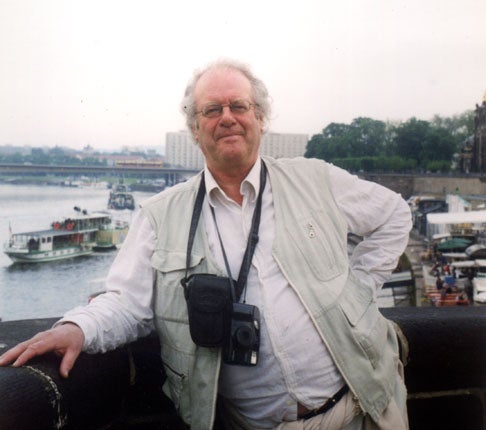Mark Glazebrook: Curator, critic, teacher and dealer whose work in the art world was imbued with his passion for life

Mark Glazebrook was a somewhat unlikely person to become a figure so integral to the art world. The son of a Liverpool cotton merchant and landowner, Mark's future was predicted early on by one of his three brothers. "Mummy," he said to his Christian Scientist mother, "I do think Mark is rather bohemian, don't you?" "You're quite wrong," replied his mother firmly. "He is very bohemian."
Educated at Eton, and after doing National Service with the Welsh Guards, Glazebrook read history at Cambridge, and then continued to the Slade School of Art, breaking off briefly to visit Vienna where he studied painting under Oskar Kok-oschka. And although he continued producing charming watercolours throughout his life – he was often to be found painting in the churchyard at St Luke's churchyard in Chelsea – he was known best for his role in all aspects of the art world, his great breadth of knowledge about and passion for art, his prodigious memory and his Tigger-like enthusiasm for life. "Even his hair was enthusiastic," said a friend, recalling his leaping locks.
After a spell at the Arts Council in the early 1960s, Glazebrook became a founding director of Editions Alecto before, in 1969, he followed Bryan Robertson as Director of the Whitechapel Gallery. Robertson had really put the gallery on the map, with some of the first exhibitions of Jackson Pollock, Jasper Johns and Robert Rauschenberg among others, but had left it in a financial mess. Sadly Glazebrook, no businessman, could not dig it out of the mire, but continued Robertson's terrific tradition by putting on the first David Hockney retrospective. (His only mistake at the Whitechapel, perhaps, was to turn down the offer of an exhibition by John Lennon and Yoko Ono, but he remained unrepentant about that decision until his death.) Hockney was a lifelong friend – and, indeed most of Glazebrook's friends felt they knew Hockney himself since Mark, a great mimic, often affectionately imitated the artist.
Glazebrook was at the peak of his professional career at the White-chapel. Later, he headed the Modern British department at the Colnaghi Gallery, (where he put on a memorable Edward Wadsworth show) and later opened the Albermarle Gallery, where he featured artists like Craigie Aitchison and John Napper. But it all ended in tears, and he was forced to sell not only the many pictures he had bought as a young man in the early 1960s – Hockneys, Blakes and Klees, among others – but also his Norman Shaw house in Bedford Park, where he'd entertained so many of the young artists he encouraged.
It was a particular blow because it was here that he had enjoyed so many happy years, not only bringing up his daughter Bianca and stepson Pavel, but becoming involved in local life and helping to raise money for the Norman Shaw church next door, the heart of the community. An ill-judged boundary dispute with his neighbour and divorce from his second wife, Wanda Osinska, reduced him to an uncharacteristic low, but a year later, boosted by a successful exhibition of his pictures at the Mayor Gallery, he bought an ex-council flat in a high-rise block in rather a grim area of Kennington, south London.
"It's marvellous!" he enthused. "From my window I can see from Tower Bridge to Battersea Power Station! And there's a Henry Moore in the grounds! And the estate is in Pevsner!" He painted his flat in stark Mondrian colours and soon friends who had never set foot in a council estate before were flocking to his door. A great gourmet, he could never buy just one salmon but two – his funeral was attended not only by his many friends and colleagues but also by the local fishmonger, butcher and all the waiters from his favourite neighbourhood restaurant in Chelsea.
He was well-known in the art world as a critic, dealer, curator, teacher and lecturer; in 1976 he became Professor of Art History at San Jose State University, California, as well as the campus gallery curator. But his friends and colleagues remember him not only as a prodigious luncher – usually at the Beefsteak or the Chelsea Arts Club – but also as one of the most ebullient, funny and generous friends in the world. He was a big man, with a powerful frame, and was a great tennis player, swimmer and walker. One night, on returning to his council estate from a bibulous dinner across the river, he was confronted by a group of threatening-looking gangsters. Ever brave, he put up his fists, only to be met with gales of laughter prompted by the sight of this burly ex-Etonian squaring up under his tweed cap. Naturally Glazebrook joined in the hilarity.
Five years ago he married Cherry Moorsom, with whom he was very happy, and spent the end of his life writing articles for the Spectator, and various other publications, singing in the Chelsea Arts Club Christmas shows (and the bath), curating art exhibitions, lecturing, writing, and playing with his much-loved grandchildren, Henry and Freddie.
Virginia Ironside
Reginald Mark Glazebrook, art dealer, curator and lecturer: born Wirral, Cheshire 25 June 1936; married 1965 Elizabeth Claridge (one daughter), 1974 Wanda Osinska (one daughter, one stepson), 2004 Cherry Moorsom; died London 3 November 2009.
Join our commenting forum
Join thought-provoking conversations, follow other Independent readers and see their replies
Comments